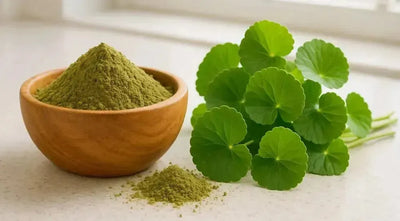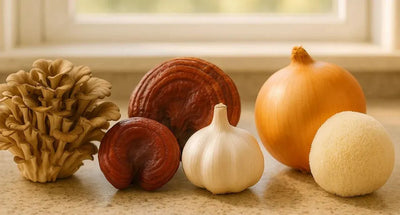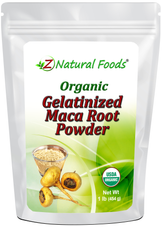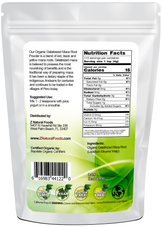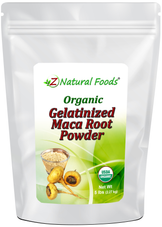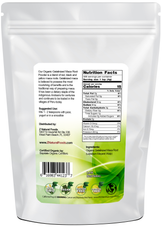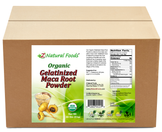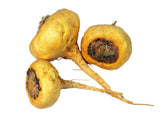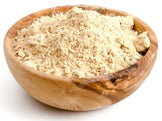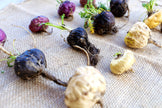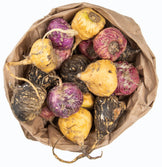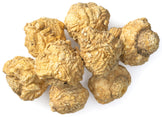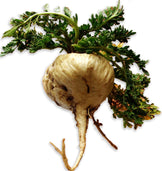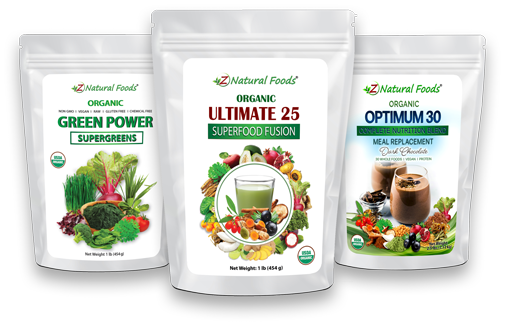Description
Description
Maca, a remarkable root vegetable, not only survives, but thrives at an altitude of 15,000 feet in the challenging conditions of the Andes mountains.
The Indigenous people of Peru have revered maca as a staple food for millennia, a testament to its unique qualities.
Despite its unassuming appearance—resembling a cross between a parsnip and a potato—it proudly belongs to the Brassica (mustard) family, which also includes cabbage, turnip, mustard, and broccoli.
Maca supports strength and health in harsh, high altitude living conditions
While Maca’s macronutrient profile can vary slightly on harvests and batches, it averages around 10.2% proteins, 59% carbohydrates, 2.2% lipids, and 8.5% of fiber.
Around one-half of Maca’s carbohydrate content is starch, specifically amylose and amylopectin.
However, with its unique long-chained fatty acids (Macaenes and Macamides) only found in Maca and its butterscotch toasted nutty flavor profile created through the gelatinizing process, this is a highly versatile food that has been proven to bring unique qualities to the table.
Peruvian festivals annually celebrate the nourishing qualities and versatility of foods prepared with Maca. The Indigenous people of Peru are known to consume various mixtures of porridge containing substantial amounts of Maca daily, a practice that supports their strength and health in the face of the harsh living conditions at high altitudes. This porridge can be cooked plain, with a touch of sugar, or with quinoa, cacao, and lucuma, all of which are staple foods in Peru.
Today's article discusses whether maca is an actual adaptogen or a tonic with adaptogen-like qualities. Please note, when we use the term “adaptogen-like” qualities, we refer to food, mushroom, or herb that takes on some of the many attributes that define an adaptogen but don’t quite fulfill the entire criteria.
Adaptogens vs. tonics; the difference
What are Adaptogens?
Adaptogens, a unique category of plants, are a supportive tool for managing a healthy stress response through nonspecific physiological reactions. What sets them apart is their remarkable ability to adapt to the harsh conditions in which they are grown. This adaptability allows them to thrive and become robust plants.
As the research on adaptogens has been compiled over the years, herbalists and scientists have learned and concluded how each adaptogen's energy (warming, cooling, drying, moistening) and constituents balance has allowed them to be used in a more specific targeted approach.
For example, there are calming adaptogens and stimulating adaptogens. Furthermore, it is common to use companion herbs like nervines, which support the nervous system and the overall effects of adaptogens.
Plants and fungi are often categorized based on their functional qualities. Unfortunately, many plants and fungi are called adaptogens even though they don’t fulfill the criteria that define an adaptogen. Therefore, it is essential to understand the requirements for how adaptogens are defined and how they work. The following are primary points that describe what a plant or fungi must do to be considered an adaptogen.
Adaptogens must:
1. Be nontoxic at clinical dosage
2. Increase the resistance of the hormonal and immune systems to all kinds of stressors through a nonspecific physiological response.
3. Normalize body function no matter how external stressors have altered them.
However, as research has progressed, we have learned that the primary factor that defines plants and fungi as adaptogens is their ability to work through one or both of the body’s master control systems.
1) The HPA Axis (Hypothalamic-Pituitary-Adrenal Axis) is a complex system of neuroendocrine pathways and feedback loops that maintains and supports homeostasis in response to chronic stress. The HPA axis interfaces the endocrine, nervous, immune, digestive, reproductive, and cardiovascular systems.
2) The SAS (Sympatho Adrenal system, aka fight or flight) is a complex system that connects the sympathetic nervous system to the adrenal medulla. In simple terms, it is our fight-or-flight response. A triggered response floods our system with adrenalin and releases hormones epinephrine and norepinephrine from the adrenal medulla. This response increases blood pressure, blood sugar, and heart rate and suppresses digestion. This releasing of hormones and redistribution of blood allows the mind and body to respond and survive.
In the early 2000s, we learned through preliminary animal and in vivo research that adaptogens also work on a “cellular level.”
It seems that adaptogens may support the upregulation of what are known as “molecular chaperones,” like heat shock proteins. Molecular chaperones are any protein that interacts with, stabilizes, or helps another protein to maintain its structure. Heat shock proteins are known for their role in protein maturation, re-folding, and degradation. They are upregulated in the presence of stressful stimuli.
The body is signaled that stress is coming, so to prepare, it increases the production of these remarkable compounds, which inhibit addiction, reduce pain, prevent protein misfolding, and increase neuroplasticity, just to name a few.
Stress also increases the production of stress hormones like cortisol.
Human research has shown that adaptogens may also support healthy cortisol levels and prevent elevated cortisol-produced mitochondrial dysfunction.
What are Tonics?
In simple terms, four primary fundamental aspects define a tonic herb:
-
Tonic herbs create and support a state of physical, mental, and emotional well-being through balance to attain vibrant health.
-
Tonic herbs can be used for an unlimited period with no adverse effects
-
No matter how long an individual uses tonic herbs, they never build up a tolerance.
-
Proper tonics come from their authentic source and spiritual homeland.
Tonic herbs are not used to treat or prevent specific issues. They promote and support general well-being by enhancing energy and regulating function. The priority is not about healing but gently promoting one’s health.
Many countries have a traditionally used herb for supporting sexual vigor, or as many locals call it, “energy,” which they tout as their local “Ginseng” (even though there is no actual relation to the ginseng family).
For example, Ashwagandha is called Indian ginseng, and Tongkat Ali is called Malaysian ginseng. Maca root is known as Peruvian Ginseng and has quite a reputation for its ability to revitalize one’s vitality and energy. Maca contains potent compounds, providing the body with a beautiful synergy of nourishment. Macamides, Macaenes, and glucosinolates seem to be what research feels may help to give maca some of its possible supportive effects.
The research has been quite conclusive in determining that it is most potent as a whole concentrated food (versus standardizing it). While macamides, macaenes, and glucosinolates are only found in small amounts, the synergy of these compounds packs a powerful punch. As stated earlier, maca is unique because it’s the only food in the Brassicaceae family where this combination of compounds occurs.
Contrary to popular belief, the effects of maca on different physiological processes do not seem to be regulated by direct changes to hormone levels. For example, sexual desire is controlled by the balancing of hormone levels. The specific effects maca has on one’s vitality are not because it directly affects individual hormone levels but because the natural sterols in maca perform healthy “hormone-like functions.” The macamides and macaenes found in maca may influence brain centers that regulate the endocrine system and energy levels.
The human study below perfectly shows how maca had no specific direct effect on individual hormones. The positive results are based on indirect effects supported by other mechanisms of action.
A randomized, double-blind, placebo-controlled, cross-over study was conducted on 29 post-menopausal women. They received 3.3 g/day of Maca or placebo for six weeks each, in either order, over 12 weeks. At baseline, week six, and week twelve, estradiol, follicle-stimulating hormone (FSH), sex hormone binding globulin (SHBG), stimulating thyroid hormone (TSH), total lipid profiles, glucose, and serum cytokines were measured. The Greene Climacteric, SF-36 Version 2, Women's Health Questionnaire, and Utian Quality of Life Scales were used to assess the severity of menopausal symptoms and health-related quality of life.
The results showed no differences in estradiol, FSH, TSH, SHBG, glucose, lipid profiles, and serum cytokines among those who received Maca compared to the placebo group; however, significant decreases in diastolic blood pressure and depression were apparent after Maca treatment. Thus, it was concluded that Maca did not exert hormonal or immune biological action in the small cohort of patients studied.
Therefore, is Maca an Adaptogen or Tonic with Adaptogen-like qualities?
When we evaluate the evidence, we can only conclude that Maca is a powerful food with a fantastic history of safety and effectiveness that provides the nourishment to build layers of resilience with long-term consumption.
However, as we have stated in many of our articles, we believe that to consider a food or herb an adaptogen or tonic, it must fulfill the specific criteria for that category.
Therefore, while there is no doubt that Maca is a tonic with many adaptogen-like qualities, more evidence of its ability to directly affect the master control systems of the body is needed to consider Maca an actual adaptogen.
For more information about our Organic Gelatinized Maca Root, go here:
Maca Root Gelatinized Powder - Organic
For more information about all of our Maca Root Powders and our other Herb and Root powders, go here:
About Michael Stuchiner, Master Herbalist
Michael Stuchiner is a Master Herbalist and proud graduate of The School of Natural Healing and has worked in different areas of this field for over 25 years. He is a retired elite-level powerlifter who competed for 27 years. As an avid international traveler, he is passionate about the use of medicinal and tonic herbs, as well as foods traditionally found in local markets in the 35 countries he has visited. Michael brings you his years of experience as a Master Herbalist, traveler, and athlete through the hundreds of articles he has written and his YouTube channel (A Master Herbalist Perspective). He is considered a true educator in this field. For more articles written by Mike, go here: Master Herbalist.

